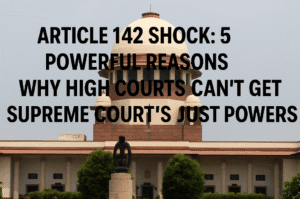Article 142 Shock: 5 Powerful Reasons Why High Courts Can’t Get Supreme Court’s Justice Powers
India’s Supreme Court dismissed a plea seeking to extend its exclusive Article 142 powers—enabling “complete justice” through unconventional orders—to high courts, asserting such a move requires parliamentary approval. The bench emphasized the constitutional design restricts this authority to the apex court, preventing fragmented rulings across states. The plea followed the Court’s landmark use of Article 142 in the Tamil Nadu vs. Governor case, where it overrode gubernatorial delays to enact stalled bills.
Critics, including Vice-President Dhankhar, caution against judicial overreach, while supporters argue it checks executive obstruction. By redirecting the issue to Parliament, the ruling underscores the judiciary’s respect for legislative boundaries. The decision reinforces India’s federal balance, affirming that systemic reforms, like redefining institutional roles, demand democratic consensus, not judicial mandates.

Article 142 Shock: 5 Powerful Reasons Why High Courts Can’t Get Supreme Court’s Justice Powers
In a decisive ruling, India’s Supreme Court dismissed a petition seeking to extend its extraordinary powers under Article 142 of the Constitution to high courts, emphasizing that such a move would require parliamentary intervention. The verdict underscores the delicate balance of power in India’s democracy and reaffirms the unique role of the apex court as the ultimate arbiter of justice.
The Petition and the Court’s Stand
The plea, filed by NGO Abhinav Bharat Congress, argued that granting high courts the authority to pass orders “necessary for complete justice” (a power currently exclusive to the Supreme Court under Article 142) would expedite resolution of state-level disputes. However, a bench of Justices Abhay S. Oka and Ujjal Bhuyan swiftly rejected the idea, stating, “How can we grant such prayer? It requires a constitutional amendment. You go to Parliament.”
The Court clarified that Article 142 is a unique tool designed to address gaps in law or procedural hurdles in the interest of justice, but its application is intentionally restricted to the Supreme Court. High courts, while powerful, derive their authority from Article 226, which allows writ jurisdiction but stops short of the sweeping, quasi-legislative powers under Article 142.
Why Article 142 Matters
Article 142 has been pivotal in landmark judgments, enabling the Court to:
- Resolve complex disputes beyond existing legal frameworks (e.g., the Babri Masjid case).
- Ensure enforcement of rights when statutes fall short (e.g., mandating compensation for Bhopal gas tragedy victims).
- Hold authorities accountable, as seen in the recent Tamil Nadu vs. Governor case, where the Court deemed 10 stalled bills as law after the governor’s inaction.
Critics, however, argue the provision risks judicial overreach. Vice-President Jagdeep Dhankhar recently likened it to a “nuclear missile,” accusing the judiciary of encroaching on legislative turf. Opposition leaders countered, defending the Court’s role as a check on executive obstruction—a tension highlighting India’s evolving federal dynamics.
The Tamil Nadu Precedent and Its Ripple Effects
The Supreme Court’s use of Article 142 in the Tamil Nadu case marked a historic moment. By circumventing Governor R.N. Ravi’s delay in approving bills, the Court reinforced constitutional deadlines for governors and the President to act on legislation. This decision not only resolved a political impasse but also set a precedent for accountability in India’s federal structure.
The ruling likely inspired the NGO’s petition, reflecting a broader debate: Should high courts have similar powers to address state-level stalemates? Legal experts are divided. While some argue it would empower regional judiciaries, others warn of inconsistent rulings and jurisdictional conflicts.
The Bigger Picture: Separation of Powers
The Supreme Court’s refusal to expand Article 142 underscores a constitutional principle: extraordinary powers demand extraordinary safeguards. Granting such authority to 25 high courts could lead to fragmented interpretations of justice, undermining legal uniformity. As Senior Advocate Rajeev Dhavan notes, “Article 142 is a safety valve, not a free pass. Its restrained use preserves the Court’s moral authority.”
The verdict also signals caution against blurring judicial and legislative roles. While the Court can intervene in exceptional cases, systemic reforms—like clearer timelines for governors to act on bills—must come from legislatures.
Conclusion: A Delicate Balance
The Supreme Court’s dismissal reinforces the Constitution’s framework, where each branch operates within defined boundaries. For high courts to gain Article 142-like powers, Parliament must amend the Constitution—a politically fraught process. Until then, the ruling reminds citizens that while justice must be swift, it cannot bypass democratic processes.
As India grapples with federal disputes and executive-judicial tensions, this decision serves as a reminder: In a democracy, even the pursuit of justice must respect the rules of the game.
You must be logged in to post a comment.